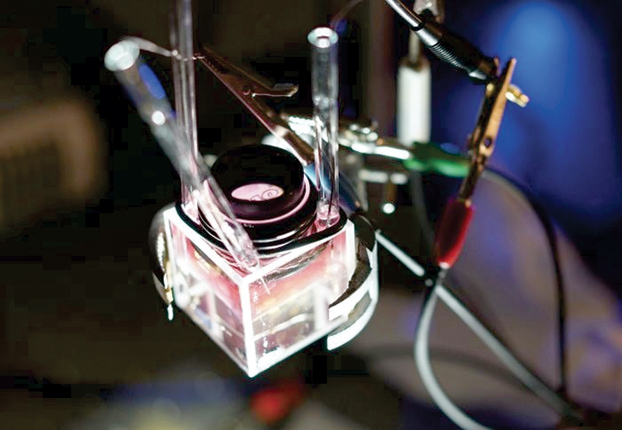Now you see this nanoplasmonic mirror. Now you don’t.
DOI: 10.1063/PT.3.3757
Surface plasmons—collective, light-driven oscillations of electrons in metal—have given us stained glass, flat lenses, and home pregnancy tests. Now they bring us the mirror–window, a liquid mirror whose reflectivity can be tuned, or eliminated altogether, with an applied voltage.

JOSHUA EDEL

Developed by researchers led by Alexei Kornyshev, Anthony Kucernak, and Joshua Edel at Imperial College London, the device makes use of gold nanoparticles inside a cell filled with two immiscible electrolyte solutions—one aqueous, the other oily. Dispersed throughout one phase or the other, the nanoparticles interact negligibly with light, and the cell is transparent. But when the particles form a dense monolayer at the liquid–liquid interface, their plasmon resonances couple to each other and they become optically reflective.
To enable switching between those two states, Kornyshev and his coworkers charged their nanoparticles by tethering organic molecules to them. At equilibrium, the charged particles prefer the aqueous phase. But a few-hundred-millivolt potential applied across the two phases coaxes the particles to assemble at the interface. For the tactic to work, the particles must be just the right size: too small and the coupled plasmons won’t resonate at visible wavelengths; too large and the particles will clump irreversibly. Particles around 16 nm in diameter gave the sought-after strong optical response—about 25% maximum reflectivity at visible wavelengths—and the organic tethers helped prevent agglomeration.
The video in the online version of this piece shows the mirror–window in action: As the initially transparent cell becomes reflective, the £10 symbol on a banknote positioned beneath the cell is displaced by the face of Queen Elizabeth II, which adorns a coin above. Currently, the transition from window to mirror takes a few hours, but the group’s theoretical analysis suggests it should be possible to reduce the switching time to milliseconds. Once optimized, the technology could be used in a broad range of applications, including energy-efficient windows, switchable displays, and sensors. (Y. Montelongo et al., Nat. Mater., in press, doi:10.1038/nmat4969
